key TOYOTA FR-S 2013 Owners Manual (in English)
[x] Cancel search | Manufacturer: TOYOTA, Model Year: 2013, Model line: FR-S, Model: TOYOTA FR-S 2013Pages: 448, PDF Size: 5.59 MB
Page 2 of 448

TABLE OF CONTENTSIndex
2
1-1. Key informationKeys ..................................... 20
1-2. Opening, closing and locking the doors and
trunk
Smart key system................. 23
Wireless remote control ....... 37
Doors.................................... 40
Trunk .................................... 42
1-3. Adjustable components (seats, mirrors,
steering wheel)
Front seats ........................... 47
Rear seats ............................ 50
Head restraints ..................... 52
Seat belts ............................. 54
Steering wheel ..................... 61
Anti-glare inside rear view mirror.......................... 62
Outside rear view mirrors ..... 63
1-4. Opening and closing the windows
Power windows .................... 66
1-5. Refueling Opening the fuel tank cap .... 69 1-6. Theft deterrent system
Engine immobilizer system ................................ 73
Alarm .................................... 75
Theft prevention labels (U.S.A.)............................... 79
1-7. Safety information Correct driving posture ......... 80
SRS airbag (Supplemental Restraint System
airbag) ................................ 82
Front passenger occupant classification system ......... 117
Child restraint systems ....... 125
Installing child restraints ..... 129
2-1. Driving procedures Driving the vehicle .............. 140
Engine (ignition) switch....... 153
Automatic transmission ...... 162
Manual Transmission ......... 169
Turn signal lever ................. 172
Parking brake ..................... 173
Horn .................................... 174
2-2. Instrument cluster Gauges and meters ............ 175
Indicators and warning lights ................................. 179
Multi-information display ..... 183
1Before driving
2When driving
Page 4 of 448

TABLE OF CONTENTSIndex
4
4-3. Do-it-yourself maintenance
Do-it-yourself service precautions ...................... 260
Hood................................... 263
Positioning a floor jack ....... 265
Engine compartment .......... 267
Tires ................................... 280
Tire inflation pressure......... 287
Wheels ............................... 291
Air conditioning filter ........... 294
Electronic key battery ......... 296
Checking and replacing fuses ................................ 298
Light bulbs .......................... 306
5-1. Essential information Emergency flashers ........... 318
If your vehicle needs to be towed .......................... 319
If you think something is wrong ............................ 326
Fuel pump shut off system .............................. 327 5-2. Steps to take in an
emergency
If a warning light turns on or a warning buzzer
sounds... .......................... 328
If you have a flat tire ........... 341
If the engine will not start .... 352
If the shift lever cannot be shifted from P ................... 355
If you lose your keys ........... 356
If the electronic key does not operate properly ......... 357
If the battery is discharged ........................ 361
If your vehicle overheats..... 365
If the vehicle becomes stuck ................................. 368
If your vehicle has to be stopped in an
emergency........................ 370
6-1. Specifications Maintenance data (fuel, oil level, etc.) ........... 372
Fuel information .................. 384
Tire information................... 388
6-2. Customization Customizable features ........ 401
5When trouble arises
6Vehicle specifications
Page 17 of 448

17
Scrapping of your Scion
The SRS airbag and seat belt pretensioner devices in your Scion contain
explosive chemicals. If the vehicle is scrapped with the airbags and seat belt
pretensioners left as they are, this may cause an accident such as fire. Be
sure to have the systems of the SRS airbag and seat belt pretensioner
removed and disposed of by a qualified service shop or by your Scion dealer
before you scrap your vehicle.
Perchlorate Material
Special handling may apply, See www.dtsc.ca.gov/hazardouswaste/perchlorate.
Your vehicle has components that may contain perchlorate. These
components may include airbag, seat belt pretensioners, and wireless
remote control batteries.
CAUTION
■General precautions while driving
Driving under the influence: Never drive your vehicle when under the influ-
ence of alcohol or drugs that have impaired your ability to operate your vehi-
cle. Alcohol and certain drugs delay reaction time, impair judgment and
reduce coordination, which could lead to an accident that could result in
death or serious injury.
Defensive driving: Always drive defensively. Anticipate mistakes that other
drivers or pedestrians might make and be ready to avoid accidents.
Driver distraction: Always give your full attention to driving. Anything that dis-
tracts the driver, such as adjusting controls, talking on a cellular phone or
reading can result in a collision with resulting death or serious injury to you,
your occupants or others.
■ General precaution regarding children’s safety
Never leave children unattended in the vehicle, and never allow children to
have or use the key.
Children may be able to start the vehicle or shift the vehicle into neutral.
There is also a danger that children may injure themselves by playing with
the windows or other features of the vehicle. In addition, heat build-up or
extremely cold temperatures inside the vehicle can be fatal to children.
Page 19 of 448
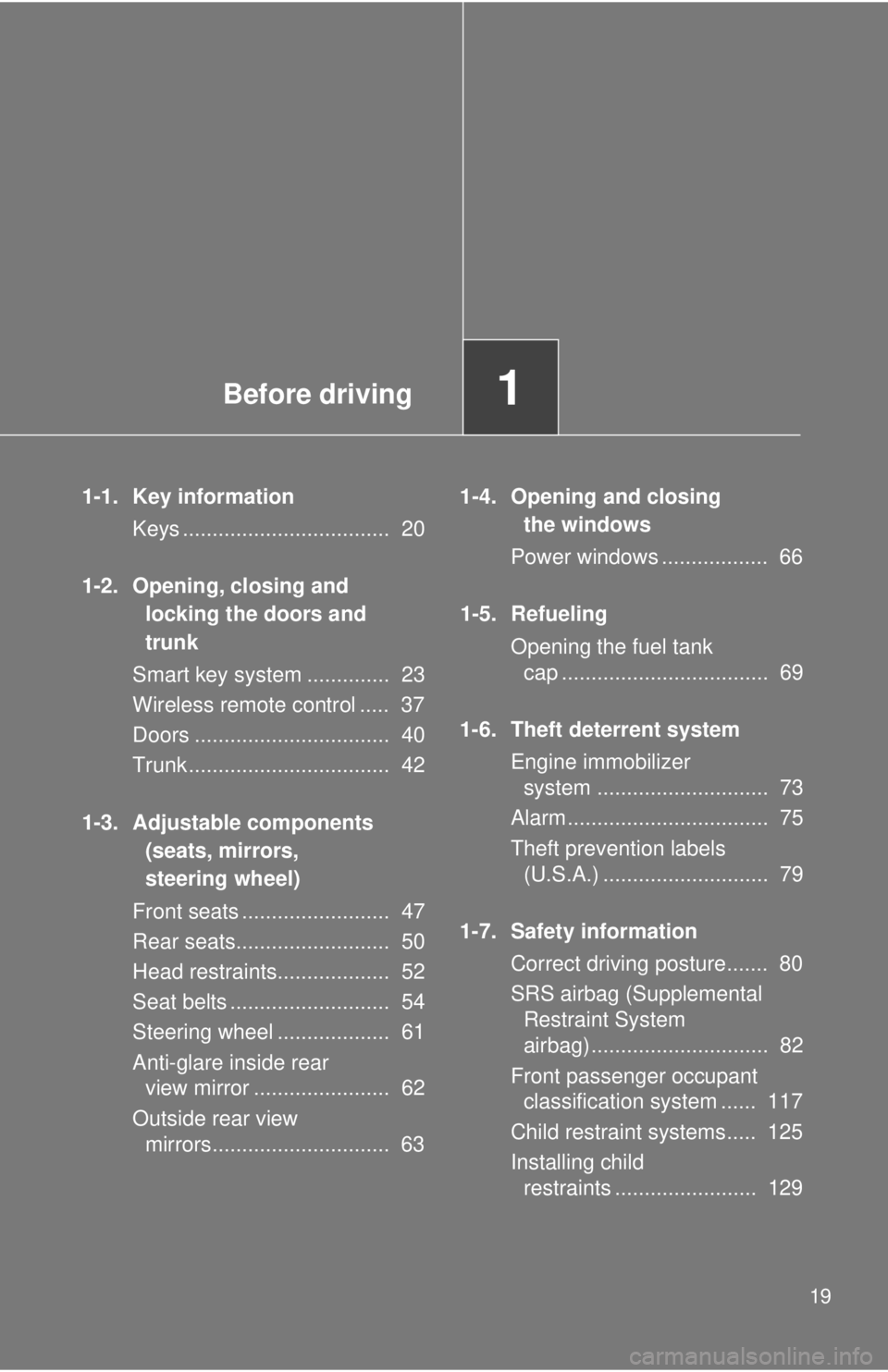
Before driving1
19
1-1. Key informationKeys ................................... 20
1-2. Opening, closing and locking the doors and
trunk
Smart key system .............. 23
Wireless remote control ..... 37
Doors ................................. 40
Trunk .................................. 42
1-3. Adjustable components (seats, mirrors,
steering wheel)
Front seats ......................... 47
Rear seats.......................... 50
Head restraints................... 52
Seat belts ........................... 54
Steering wheel ................... 61
Anti-glare inside rear view mirror ....................... 62
Outside rear view mirrors.............................. 63 1-4. Opening and closing
the windows
Power windows .................. 66
1-5. Refueling Opening the fuel tank cap ................................... 69
1-6. Theft deterrent system Engine immobilizer system ............................. 73
Alarm.................................. 75
Theft prevention labels (U.S.A.) ............................ 79
1-7. Safety information Correct driving posture....... 80
SRS airbag (Supplemental Restraint System
airbag).............................. 82
Front passenger occupant classification system ...... 117
Child restraint systems..... 125
Installing child restraints ........................ 129
Page 20 of 448
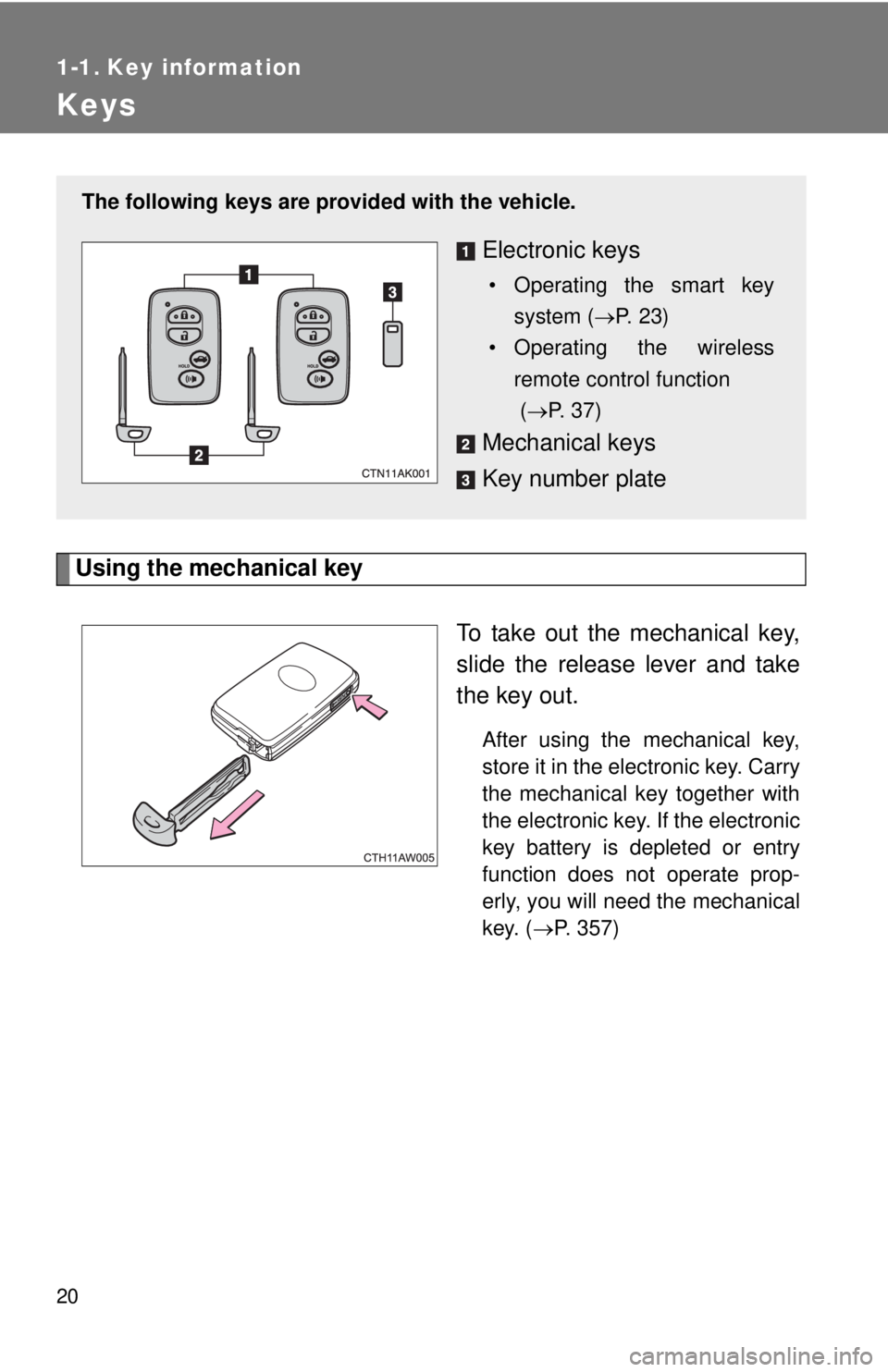
20
1-1. Key information
Keys
Using the mechanical keyTo take out the mechanical key,
slide the release lever and take
the key out.
After using the mechanical key,
store it in the electronic key. Carry
the mechanical key together with
the electronic key. If the electronic
key battery is depleted or entry
function does not operate prop-
erly, you will need the mechanical
key. (P. 357)
The following keys are provid ed with the vehicle.
Electronic keys
• Operating the smart key
system ( P. 23)
• Operating the wireless remote control function
(P. 37)
Mechanical keys
Key number plate
Page 21 of 448

21
1-1. Key information
1
Before driving
■
When required to leave the vehicle’s key with a parking attendant
Turn the trunk opener main switch off as circumstances demand. ( P. 42)
Remove the mechanical key for your own use and provide the attendant with
the electronic key only.
■ Key number plate
Keep the plate in a safe place, not in the vehicle. In the event that a mechan-
ical key is lost, a new key can be made at your Scion dealer using the key
number plate. ( P. 356)
■ When riding in an aircraft
When bringing a key with wireless remote control function onto an aircra\
ft,
make sure you do not press any buttons on the key while inside the aircraft
cabin. If you are carrying the key in your bag etc., ensure that the buttons
are not likely to be pressed accidentally. Pressing a button may cause the
key to emit radio waves that could interfere with the operation of the aircraft.
Page 22 of 448

22 1-1. Key information
NOTICE
■To prevent key damage
Observe the following:
●Do not drop the keys, subject them to strong shocks or bend them.
● Do not expose the keys to high temperatures for a long period of time.
● Do not get the keys wet or wash them in an ultrasonic washer etc.
● Do not attach metallic or magnetic materials to the keys or place the keys
close to such materials.
● Do not disassemble the keys.
● Do not attach a sticker or anything else to the surface of the key.
● Do not place the keys near objects that produce magnetic fields, such as
TVs, audio systems, glass top ranges, or medical electrical equipment,
such as low-frequency therapy equipment.
■ Carrying the electronic key on your person
Carry the electronic key 3.9 in. (10 cm) or more away from electric appli-
ances that are turned on. Radio waves emitted from electric appliances
within 3.9 in. (10 cm) of the electronic key may interfere with the key, causing
the key to not function properly.
■ In case of a smart key system malf unction or other key-related prob-
lems
Take your vehicle with all the electronic keys provided with your vehicle to
your Scion dealer.
■ When a vehicle key is lost
If the key remains lost, the risk of vehicle theft increases significantly. Visit
your Scion dealer immediately with all remaining keys that were provided
with your vehicle.
Page 23 of 448
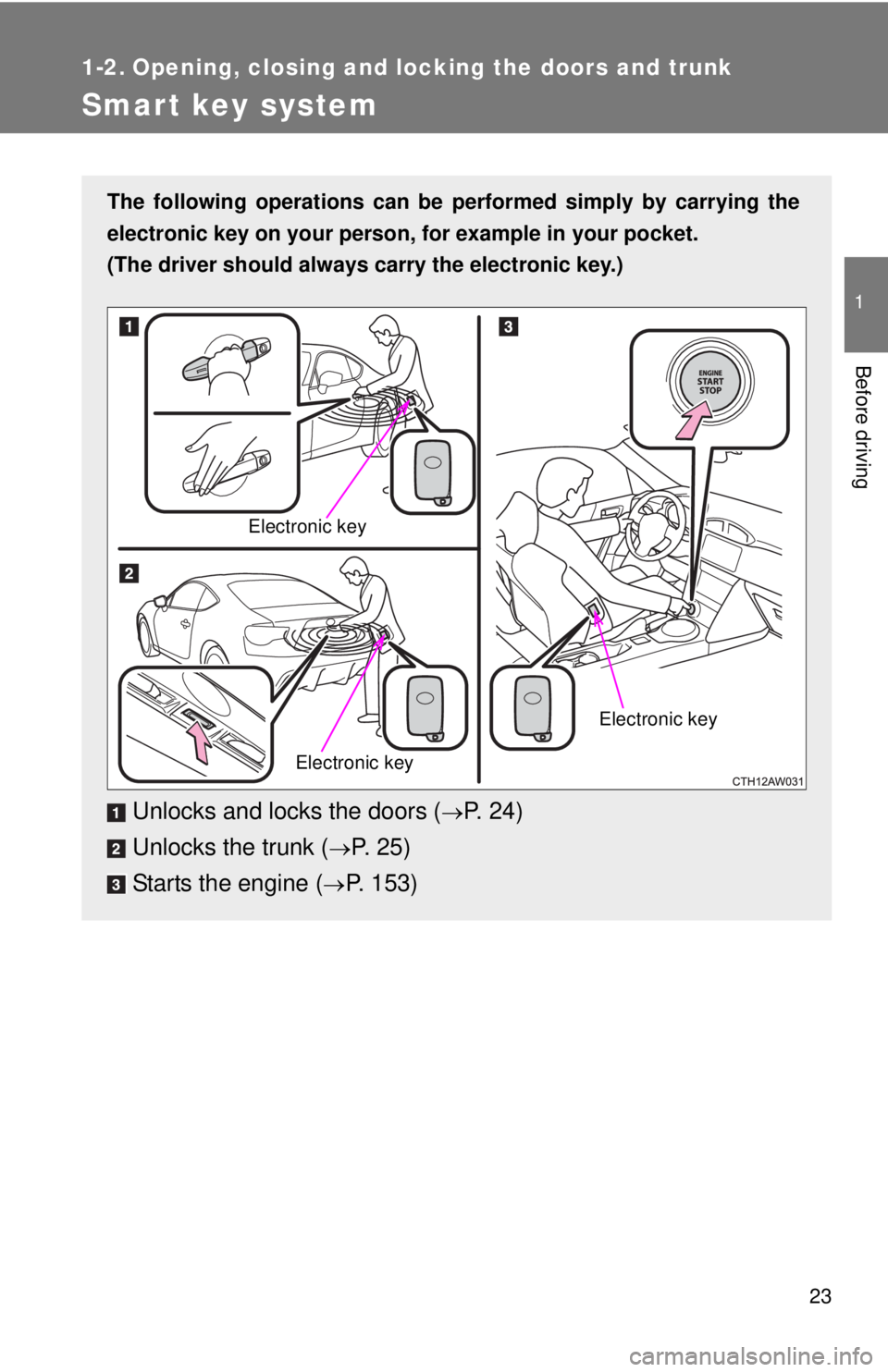
23
1
Before driving
1-2. Opening, closing and locking the doors and trunk
Smart key system
The following operations can be performed simply by carrying the
electronic key on your person, for example in your pocket.
(The driver should always carry the electronic key.)
Unlocks and locks the doors (P. 24)
Unlocks the trunk (
P. 2 5 )
Starts the engine (
P. 153)
Electronic key
Electronic key
Electronic key
Page 26 of 448
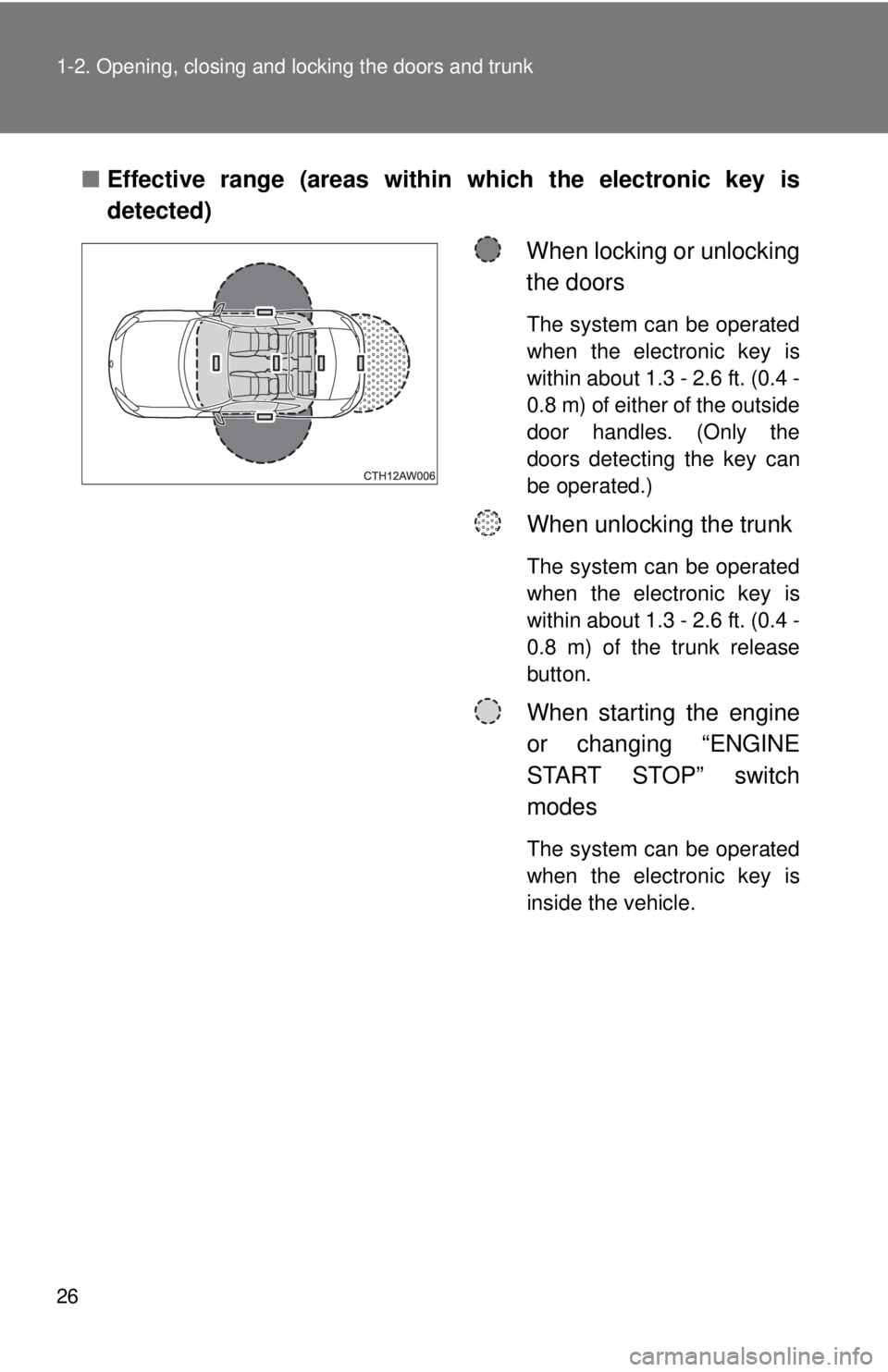
26 1-2. Opening, closing and locking the doors and trunk
■Effective range (areas within which the electronic key is
detected)
When locking or unlocking
the doors
The system can be operated
when the electronic key is
within about 1.3 - 2.6 ft. (0.4 -
0.8 m) of either of the outside
door handles. (Only the
doors detecting the key can
be operated.)
When unlocking the trunk
The system can be operated
when the electronic key is
within about 1.3 - 2.6 ft. (0.4 -
0.8 m) of the trunk release
button.
When starting the engine
or changing “ENGINE
START STOP” switch
modes
The system can be operated
when the electronic key is
inside the vehicle.
Page 28 of 448
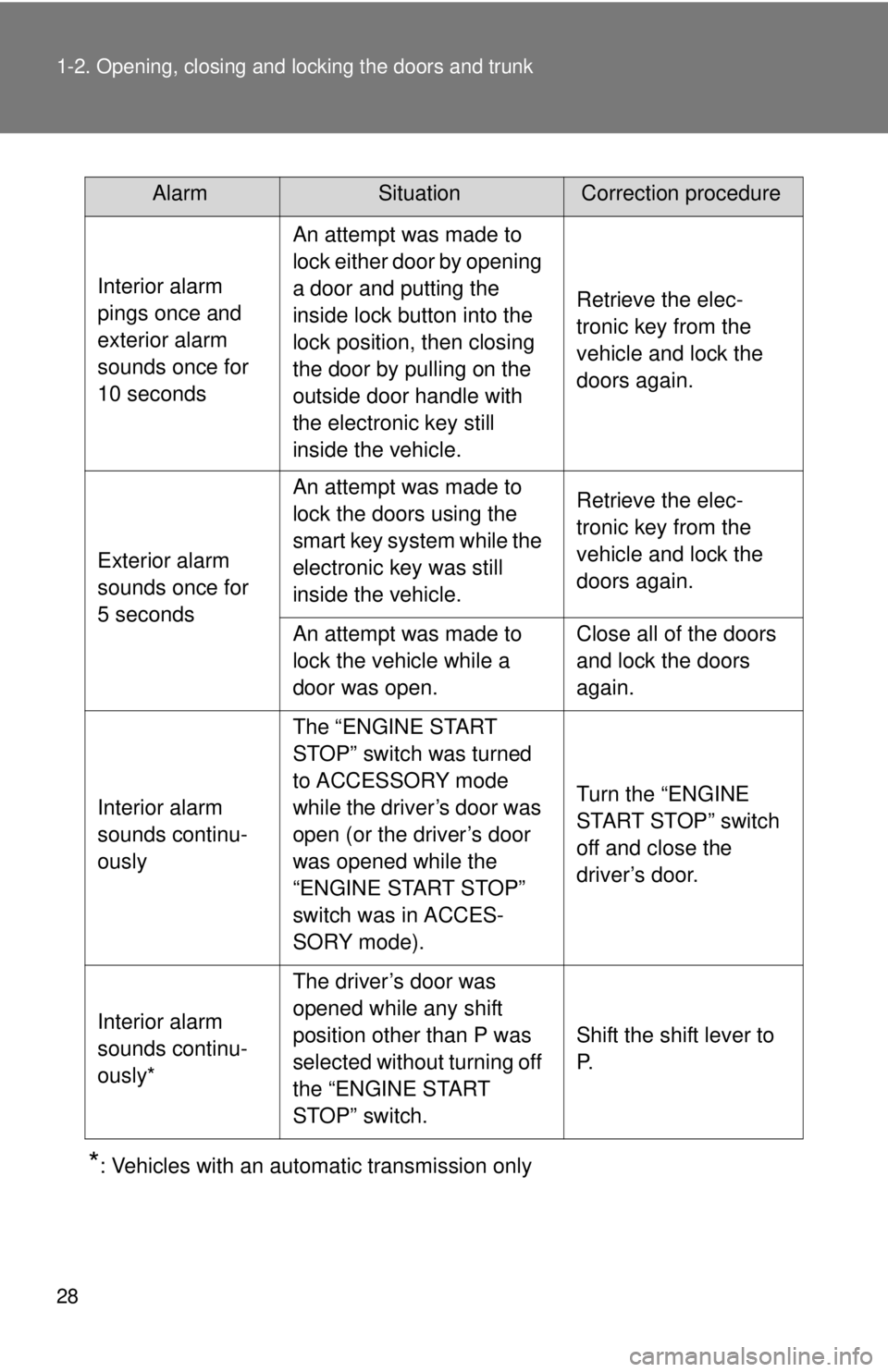
28 1-2. Opening, closing and locking the doors and trunk
*: Vehicles with an automatic transmission only
AlarmSituationCorrection procedure
Interior alarm
pings once and
exterior alarm
sounds once for
10 seconds An attempt was made to
lock either door by opening
a door and putting the
inside lock button into the
lock position, then closing
the door by pulling on the
outside door handle with
the electronic key still
inside the vehicle.
Retrieve the elec-
tronic key from the
vehicle and lock the
doors again.
Exterior alarm
sounds once for
5 seconds An attempt was made to
lock the doors using the
smart key system while the
electronic key was still
inside the vehicle.
Retrieve the elec-
tronic key from the
vehicle and lock the
doors again.
An attempt was made to
lock the vehicle while a
door was open. Close all of the doors
and lock the doors
again.
Interior alarm
sounds continu-
ously The “ENGINE START
STOP” switch was turned
to ACCESSORY mode
while the driver’s door was
open (or the driver’s door
was opened while the
“ENGINE START STOP”
switch was in ACCES-
SORY mode). Turn the “ENGINE
START STOP” switch
off and close the
driver’s door.
Interior alarm
sounds continu-
ously* The driver’s door was
opened while any shift
position other than P was
selected without turning off
the “ENGINE START
STOP” switch.
Shift the shift lever to
P.